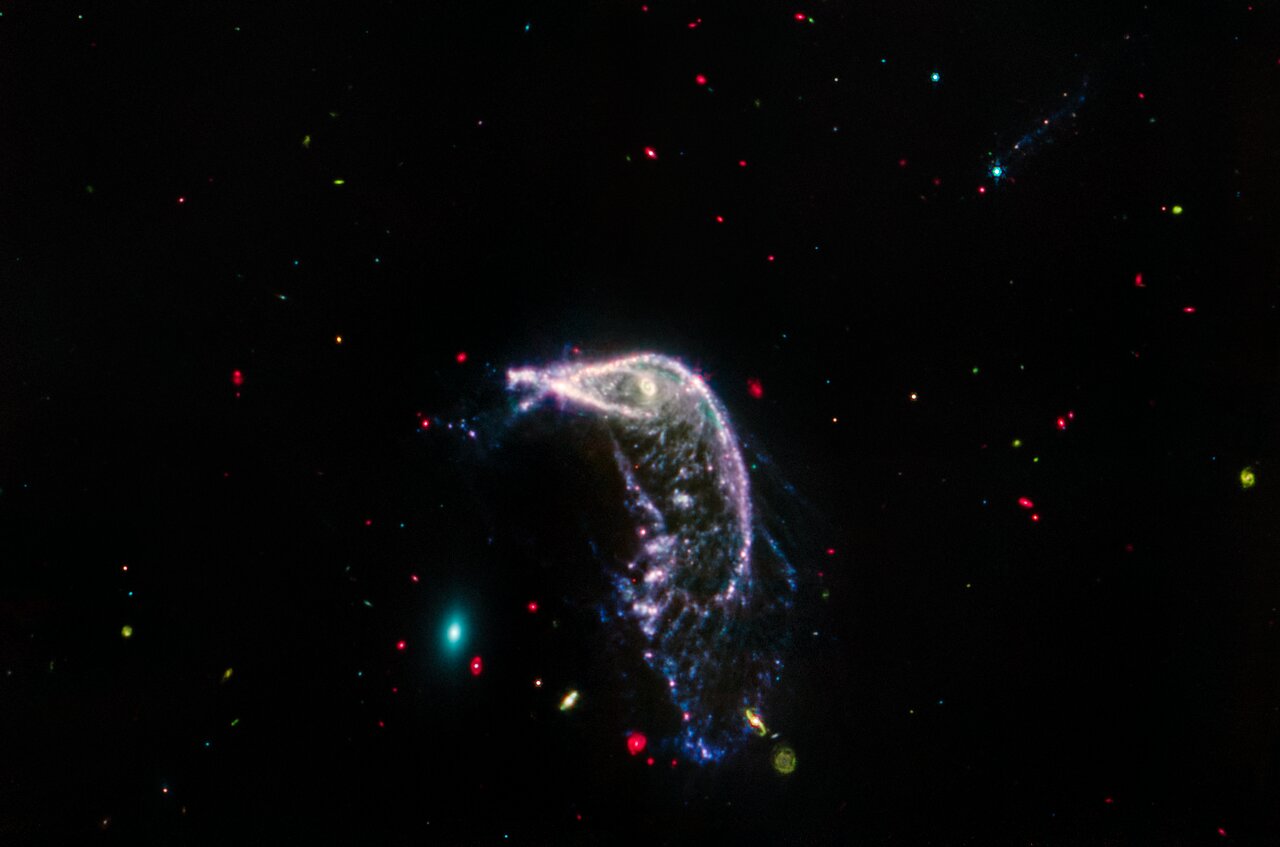About the Object
| Name: | Arp 142 | |
|---|---|---|
| Distance: |
326 million light years | |
| Constellation: | Hydra | |
| Category: | Anniversary Galaxies MIRI | |
Coordinates
| Position (RA): | 9 37 44.04 |
|---|---|
| Position (Dec): | 2° 45' 33.13" |
| Field of view: | 3.44 x 2.27 arcminutes |
| Orientation: | North is 22.8° right of vertical |
Colours & filters
| Band | Wavelength | Telescope |
|---|---|---|
|
Infrared
PAH | 7.7 μm | James Webb Space Telescope MIRI |
|
Infrared
Silicate | 10 μm | James Webb Space Telescope MIRI |
| Infrared | 15 μm | James Webb Space Telescope MIRI |
Interacting galaxies Arp 142 (MIRI image)
Webb’s mid-infrared view of interacting galaxies Arp 142 seems to sing in primary colours. The background of space is like a yawning darkness speckled with bright, multi-coloured beads.
This image was taken by MIRI, the telescope’s Mid-InfraRed Instrument, which astronomers use to study cooler and older objects, dust, and extremely distant galaxies.
Here, the Egg appears as an exceptionally small teal oval with gauzy layers. Mid-infrared light predominantly shows the oldest stars in the elliptical galaxy, which has lost or used up most of its gas and dust. This is why the view is so different from the combined image, which includes near-infrared light.
At right, the Penguin’s shape is relatively unchanged. The MIRI image shows all the gas and dust that has been distorted and stretched, as well as the smoke-like material, in blue, that includes carbon-containing molecules, known as polycyclic aromatic hydrocarbons.
Next, look for the edge-on galaxy catalogued PGC 1237172 at the top right — a dim, hazy line. Find it by looking for the bright blue star with small diffraction spikes positioned over the top of its left edge. This galaxy nearly disappears in mid-infrared light because its stars are very young and the galaxy isn’t overflowing with dust.
Now, scan the full image left to right to spot distant galaxies in the background. The red objects are encased in thick layers of dust. Some are spiral galaxies and others are more distant galaxies that can only be detected as dots or smudges. Green galaxies are laden with dust and are farther away. Bluer galaxies are closer. Zoom in carefully to see if a blue dot has minuscule diffraction spikes — those are stars, not galaxies.
[Image description: Two interacting galaxies known as Arp 142 in a horizontal image taken in mid-infrared light. At left is NGC 2937, which looks like a tiny teal oval and is nicknamed the Egg. At right is NGC 2936, nicknamed the Penguin, which is significantly larger and looks like a bird with a fanned tail.]
Credit:NASA, ESA, CSA, STScI
About the Image
| Id: | weic2420b | |
|---|---|---|
| Type: | Observation | |
| Release date: | 12 July 2024, 16:00 | |
| Related releases: | weic2420 | |
| Size: | 1861 x 1231 px | |




